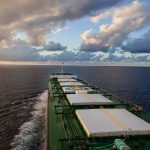Speaking at the LNG2023 conference in Vancouver, Dulles Wang, Director, of Americas Gas & LNG at Wood Mackenzie said that with the alignment of several market dynamics, Canada could be positioned to play a much bigger role in global LNG exports.
“There will certainly be challenges in building out new LNG capacity in Canada, but the country has much in its favor and could play a larger role in meeting global demand in the near future, especially in Asia,” said Dulles. “Canada could be well-positioned due to its strategic location for shipping advantages to Asia, support from Canadian First Nations, and forward-thinking emissions regulations.”
Currently, the US and Qatar account for 40 percent of the global LNG supply. With their abundance of supply, infrastructure, and commercial partnerships, Wood Mackenzie forecasts their combined market share to exceed 60 percent by 2040. The US will continue to cement its position as the largest LNG supplier in the world, building on the record-breaking commercial momentum from 2022.
Underpinned by robust LNG demand growth, Wood Mackenzie projects that another 100 mmtpa of the capacity of LNG will be required to meet demand growth by the mid-2030s, a 25 percent uplift to current supply and in addition to projects that are currently under construction. Much of this demand will be in Asia, where China and several other emerging economies are looking to rely more heavily on gas as they switch away from coal.
Said Wang, “Sustained LNG demand in Asia will drive new opportunities in the market and Canada is well-positioned to capitalize. It does have challenges, as construction costs are high for new pipelines, but support from First Nations will be critical to secure social licenses, and the potential is quite high. Canada can produce LNG with some of the lowest emissions intensity in the world thanks to its access to hydroelectricity, emissions regulations, and goals. Countries that are looking for low-emissions resources to meet their own climate goals will be attracted to this supply.
“Cost of LNG shipping is spiraling northwards with the emission intensity of the LNG fleet coming under intensified scrutiny. The shipping advantage for Canada to Asia increases substantially if ships from the US Gulf Coast need to go the long way round to reach the Asian market, due to rising congestion at the Panama Canal.”
Wang added that pricing could play a key role in Canada’s future as well. “The Canadian LNG landscape is evolving to tackle the high-cost perception. Its local benchmark, AECO, consistently trades at a healthy discount to Henry Hub prices. With its key proximity to north Asia markets, its exports can avoid the constraints of the Panama Canal and cut shipping costs by more than US$2/mmbtu compared with US Gulf Coast projects going the long way round. The industry’s adoption to near-shore FLNG technology, Canada’s carbon advantage, and LNG portfolio diversification could all increase the attractiveness of Canadian LNG in the global market.”
Source: Hellenic Shipping News





